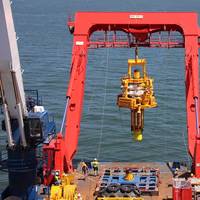BSEE Oversees Testing of Shell’s Arctic Equipment

Testing of Shell’s proposed Arctic-ready capping stack system was supervised this week by the U.S. Bureau of Safety and Environmental Enforcement (BSEE) in Puget Sound, BSEE Director Brian Salerno announced today. BSEE Alaska Region Director Mark Fesmire oversaw the testing to ensure compliance with Federal safety standards for oil and gas exploration on the Arctic Outer Continental Shelf. The capping stack, used to contain the flow of oil in the event that all primary and backup blowout prevention equipment fails during drilling…
Maersk Drilling Orders 20K™ Blow Out Preventer & Risers
Maersk Drilling has ordered four Blow Out Preventers (BOPs) and two risers from GE Oil and Gas to be used in the Project 20K™ agreement with BP. The BOPs and risers are intended to be delivered and deployed on two Maersk Drilling 20K™ Rigs by year-end 2018. The order includes options for provision of further BOPs. The order is subject to BP and Maersk Drilling taking the final investment decision on a 20K™ Rig contract. BP and Maersk Drilling announced in February 2013 a joint study agreement to develop conceptual engineering designs for a new breed of advanced technology drilling rigs that will be critical to unlocking the next frontier of deepwater oil and gas resources.
Ultra-Deepwater Drilling: Technology Design Alliance
BP signs agreement with Maersk Drilling to develop designs for a new breed of advanced technology offshore drilling rigs. The agreement is part of BP’s Project 20KTM, a multi-year initiative to develop next-generation systems and tools for deepwater exploration and production that are beyond the reach of today’s technology. BP and Maersk Drilling will collaborate on concepts for deepwater drilling rigs that can operate in high-pressure and high-temperature reservoirs up to 20,000 pounds per square inch and 350 degrees Fahrenheit. A jointly staffed engineering team will be located in Houston, with back-office support from Maersk Drilling’s headquarters in Copenhagen, Denmark.
Better Pressure Testing Saves $193m per Rig
According to ODS-Petrodata, the cost of operating a highly automated rig in the Gulf of Mexico has almost tripled in the last four years. Accordingly, the Minerals Management Service (MMS) recently funded a three-year Joint Industry Project (JIP) to determine the historical failure rates (and resulting non-productive time) associated with subsea Blowout Prevention Equipment (BOPE). Athens Group CTO and drilling technology expert, Don Shafer will be presenting the findings of that study at the AADE 2009 National Technical Conference March 31 in New Orleans, LA. “With an understanding of the causes of their failure, BOPE and control systems reliability can be increased,” said Shafer. According to the study, many stack configurations exceed minimum requirements and are redundant.
R&B Falcon Announces Deepwater Pathfinder Incident
R&B Falcon Corporation announced drillship Deepwater Pathfinder sustained damage when 20 joints of the vessel's riser and its blowout prevention equipment fell to the seabed in approximately 7,000 ft. of water while preparing to continue drilling operations in the Gulf of Mexico offshore Louisiana. None of the personnel aboard the drillship sustained any injury. The drillship's top drive and travelling equipment sustained damage, and an investigation is underway to ascertain the full extent of damages sustained. The marine integrity of the drillship was not affected. No environmental damage resulted from the incident. Deepwater Pathfinder is operated under a long-term bareboat charter by Deepwater Drilling L.L.C., a limited liability company in which affiliates of Conoco Inc.
R&B Falcon Drillship Sustains Damage
R&B Falcon's drillship Deepwater Pathfinder sustained damage recently when 20 joints of the vessel's riser and its blowout prevention equipment fell to the seabed in about 7,000 ft. (2,133 m) of water while preparing to continue drilling operations in the Gulf of Mexico offshore Louisiana. None of the personnel onboard was injured, but the drillship's top drive and traveling equipment was damaged. A full investigation is currently underway to decipher the full extent of the accident.





